Royal Engineers
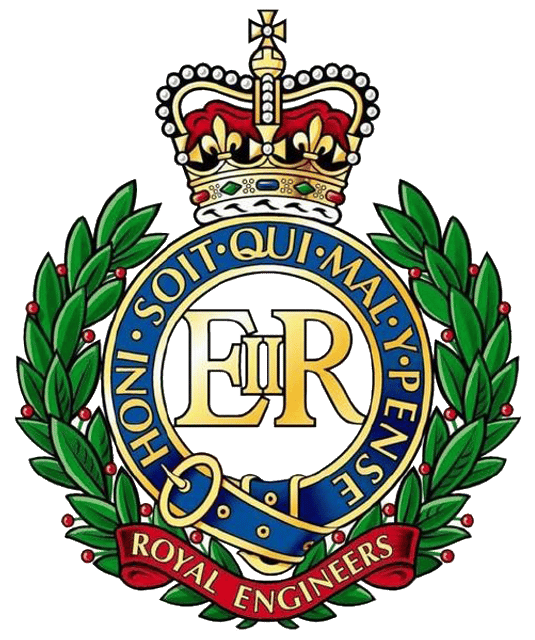
Royal Engineers

| Royal Engineers | |
|---|---|
| Active | 1716–present |
| Country | |
| Branch | |
| Size | 22 Regiments |
| Part of | Commander Field Army |
| Garrison/HQ | Chatham, Kent, England |
| Motto(s) | Ubique and Quo Fas et Gloria Ducunt ("Everywhere" and "Where Right And Glory Lead"; in Latin fas implies "sacred duty")[1] |
| March | Wings (Quick march) |
| Commanders | |
| Current commander | Chief Royal Engineer – Lt Gen Tyrone Urch CBE Corps Colonel – Col Matt Quare MBE ADC Corps Serjeant Major - WO1 Paul Clark RE |
| Chief Royal Engineer | Lieutenant General Tyrone Urch CBE |
| Insignia | |
| Tactical recognition flash |  |
The Corps of Royal Engineers, usually just called the Royal Engineers (RE), and commonly known as the Sappers, is one of the corps of the British Army.
It provides military engineering and other technical support to the British Armed Forces and is headed by the Chief Royal Engineer. The Regimental Headquarters and the Royal School of Military Engineering are in Chatham in Kent, England. The corps is divided into several regiments, barracked at various places in the United Kingdom and around the world.
| Royal Engineers | |
|---|---|
| Active | 1716–present |
| Country | |
| Branch | |
| Size | 22 Regiments |
| Part of | Commander Field Army |
| Garrison/HQ | Chatham, Kent, England |
| Motto(s) | Ubique and Quo Fas et Gloria Ducunt ("Everywhere" and "Where Right And Glory Lead"; in Latin fas implies "sacred duty")[1] |
| March | Wings (Quick march) |
| Commanders | |
| Current commander | Chief Royal Engineer – Lt Gen Tyrone Urch CBE Corps Colonel – Col Matt Quare MBE ADC Corps Serjeant Major - WO1 Paul Clark RE |
| Chief Royal Engineer | Lieutenant General Tyrone Urch CBE |
| Insignia | |
| Tactical recognition flash |  |
History
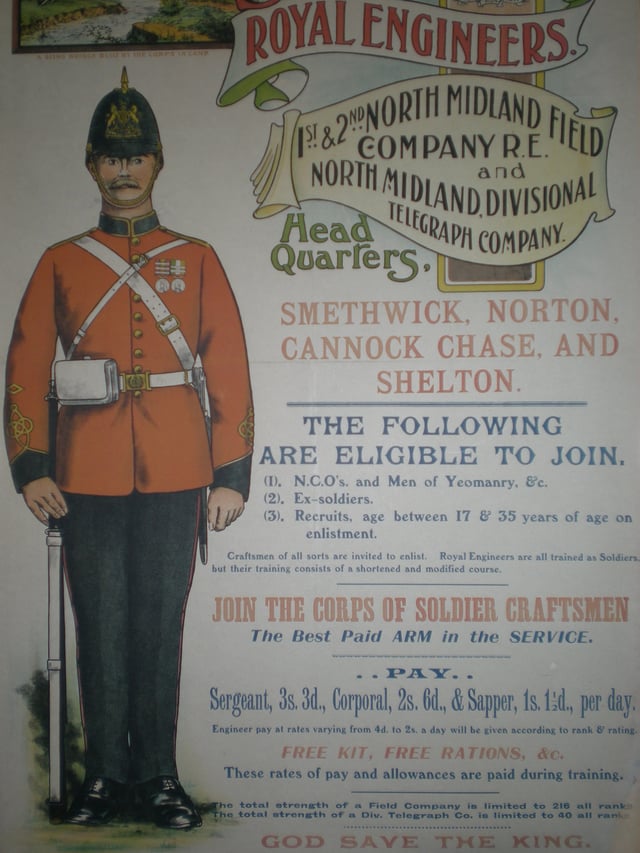
Royal Engineers recruitment poster
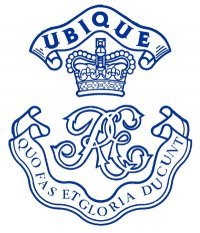
Corps of Royal Engineers Cypher
The Royal Engineers trace their origins back to the military engineers brought to England by William the Conqueror, specifically Bishop Gundulf of Rochester Cathedral, and claim over 900 years of unbroken service to the crown. Engineers have always served in the armies of the Crown; however, the origins of the modern corps, along with those of the Royal Artillery, lie in the Board of Ordnance established in the 15th century.[2]
In Woolwich in 1716, the Board formed the Royal Regiment of Artillery and established a Corps of Engineers, consisting entirely of commissioned officers. The manual work was done by the Artificer Companies, made up of contracted civilian artisans and labourers. In 1772, a Soldier Artificer Company was established for service in Gibraltar, the first instance of non-commissioned military engineers. In 1787, the Corps of Engineers was granted the Royal prefix and adopted its current name and in the same year a Corps of Royal Military Artificers was formed, consisting of non-commissioned officers and privates, to be led by the RE. Ten years later the Gibraltar company, which had remained separate, was absorbed and in 1812 the name was changed to the Corps of Royal Sappers and Miners.[2]
The Corps has no battle honours. In 1832, the regimental motto, Ubique & Quo Fas Et Gloria Ducunt ("Everywhere" & "Where Right And Glory Lead"; in Latin fas implies "sacred duty") was granted.[1] The motto signified that the Corps had seen action in all the major conflicts of the British Army and almost all of the minor ones as well.[3][4]
In 1855 the Board of Ordnance was abolished and authority over the Royal Engineers, Royal Sappers and Miners and Royal Artillery was transferred to the Commander-in-Chief of the Forces, thus uniting them with the rest of the Army. The following year, the Royal Engineers and Royal Sappers and Miners became a unified corps as the Corps of Royal Engineers and their headquarters were moved from the Royal Arsenal, Woolwich, to Chatham, Kent.[2]
The re-organisation of the British military that began in the mid-Nineteenth Century and stretched over several decades included the reconstitution of the Militia, the raising of the Volunteer Force, and the ever-closer organisation of the part-time forces with the regular army.[5] The old Militia had been an infantry force, other than the occasional employment of Militiamen to man artillery defences and other roles on an emergency basis. This changed in 1861, with the conversion of some units to artillery roles. Militia and Volunteer Engineering companies were also created, beginning with the conversion of the militia of Anglesey and Monmouthshire to engineers in 1877. The Militia and Volunteer Force engineers supported the regular Royal Engineers in a variety of roles, including operating the boats required to tend the submarine mine defences that protected harbours in Britain and its empire. These included a submarine mining militia company that was authorised for Bermuda in 1892, but never raised, and the Bermuda Volunteer Engineers that wore Royal Engineers uniforms and replaced the regular Royal Engineers companies withdrawn from the Bermuda Garrison in 1928.[6][7] The various part-time reserve forces were amalgamated into the Territorial Force in 1908,[8] which was retitled the Territorial Army after the First World War, and the Army Reserve in 2014.[9]
In 1911 the Corps formed its Air Battalion, the first flying unit of the British Armed Forces. The Air Battalion was the forerunner of the Royal Flying Corps and Royal Air Force.[10]
In 1915, in response to German mining of British trenches under the then static siege conditions of the First World War, the corps formed its own tunnelling companies. Manned by experienced coal miners from across the country, they operated with great success until 1917, when after the fixed positions broke, they built deep dugouts such as the Vampire dugout to protect troops from heavy shelling.[11]
Before the Second World War, Royal Engineers recruits were required to be at least 5 feet 4 inches tall (5 feet 2 inches for the Mounted Branch). They initially enlisted for six years with the colours and a further six years with the reserve or four years and eight years. Unlike most corps and regiments, in which the upper age limit was 25, men could enlist in the Royal Engineers up to 35 years of age. They trained at the Royal Engineers Depot in Chatham or the RE Mounted Depot at Aldershot.[12]
During the 1980s, the Royal Engineers formed the vital component of at least three Engineer Brigades: 12 Engineer Brigade (Airfield Damage Repair);[13] 29th Engineer Brigade; and 30th Engineer Brigade.[14] After the Falklands War, 37 (FI) Engineer Regiment was active from August 1982 until 14 March 1985.[15]
Regimental museum
The Royal Engineers Museum is in Gillingham in Kent.[16]
Significant constructions
British Columbia
The Royal Engineers, Columbia Detachment, commanded by Richard Clement Moody, was responsible for the foundation and settlement of British Columbia as the Colony of British Columbia.[18][19]
Royal Albert Hall
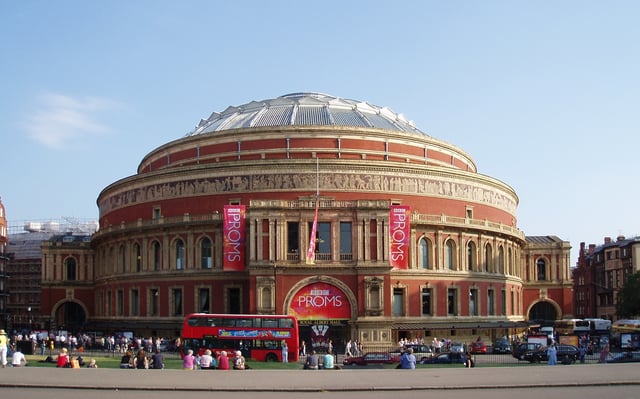
The Royal Albert Hall, designed by Captain Francis Fowke RE
The Royal Albert Hall is one of the UK's most treasured and distinctive buildings, recognisable the world over. Since its opening by Queen Victoria in 1871, the world's leading artists from every kind of performance genre have appeared on its stage. Each year it hosts more than 350 performances including classical concerts, rock and pop, ballet and opera, tennis, award ceremonies, school and community events, charity performances and lavish banquets. The Hall was designed by Captain Francis Fowke and Major-General Henry Y. D. Scott of the Royal Engineers and built by Lucas Brothers.[20] The designers were heavily influenced by ancient amphitheatres, but had also been exposed to the ideas of Gottfried Semper while he was working at the Victoria and Albert Museum.[21]
Indian infrastructure
Much of the British colonial era infrastructure of India, of which elements survive today, was created by engineers of the three presidencies' armies and the Royal Engineers. Lieutenant (later General Sir) Arthur Thomas Cotton (1803–99), Madras Engineers, was responsible for the design and construction of the great irrigation works on the river Cauvery, which watered the rice crops of Tanjore and Trichinopoly districts in the late 1820s. In 1838 he designed and built sea defences for Vizagapatam. He masterminded the Godavery Delta project where 720,000 acres (2,900 km2) of land were irrigated and 500 miles (800 km) of land to the port of Cocanada was made navigable in the 1840s. Such regard for his lasting legacy was shown when in 1983, the Indian Government erected a statue in his memory at Dowleswaram.[22]
Other irrigation and canal projects included the Ganges Canal, where Colonel Sir Colin Scott-Moncrieff (1836–1916) acted as the Chief Engineer and made modifications to the original work. Among other engineers trained in India, Scott-Moncrieff went on to become Under Secretary of State Public Works, Egypt where he restored the Nile barrage and irrigation works of Lower Egypt.[23]
Rideau Canal
The construction of the Rideau Canal was proposed shortly after the War of 1812, when there remained a persistent threat of attack by the United States on the British colony of Upper Canada. The initial purpose of the Rideau Canal was military, as it was intended to provide a secure supply and communications route between Montreal and the British naval base in Kingston, Ontario. Westward from Montreal, travel would proceed along the Ottawa River to Bytown (now Ottawa), then southwest via the canal to Kingston and out into Lake Ontario. The objective was to bypass the stretch of the St. Lawrence River bordering New York State, a route which would have left British supply ships vulnerable to attack or a blockade of the St. Lawrence. The construction of the canal was supervised by Lieutenant-Colonel John By of the Royal Engineers. In 2007 it was inscribed as a UNESCO World Heritage Site recognizing it as a work of human creative genius. The Rideau Canal was recognized as the best preserved example of a slack water canal in North America demonstrating the use of European slackwater technology in North America on a large scale. Lt. Denison was one of the junior Royal Engineers who worked under Lt. Colonel John By, RE on the Rideau Canal in Upper Canada (1826–1832). Of note, Denison carried out experiments under the direction of Lt. Col. By to determine the strength, for construction purposes of the old growth timber in the vicinity of Bytown. His findings were published by the Institution of Civil Engineers in England who bestowed upon him the prestigious Telford Medal.[24]
Dover's Western Heights
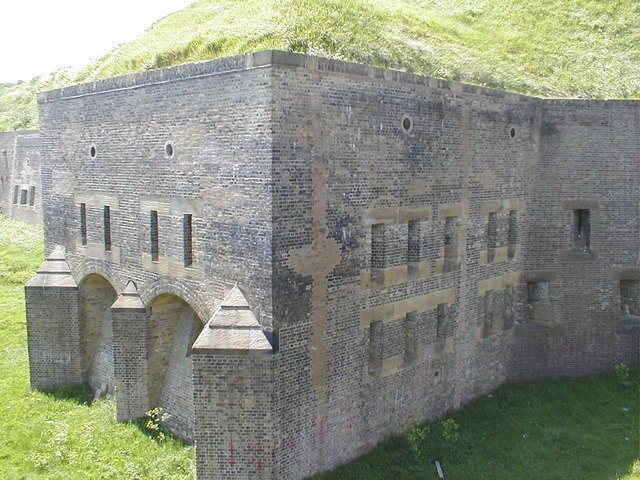
Drop Redoubt.
The Western Heights of Dover are one of the most impressive fortifications in Britain. They comprise a series of forts, strong points and ditches, designed to protect the United Kingdom from invasion. They were created to augment the existing defences and protect the key port of Dover from both seaward and landward attack. First given earthworks in 1779 against the planned invasion that year, the high ground west of Dover, England, now called Dover Western Heights, was properly fortified in 1804 when Lieutenant-Colonel William Twiss was instructed to modernise the existing defences. This was part of a huge programme of fortification in response to Napoleon's planned invasion of the United Kingdom. To assist with the movement of troops between Dover Castle and the town defences Twiss made his case for building the Grand Shaft in the cliff:
"... the new barracks. ... are little more than 300 yards horizontally from the beach. ... and about 180 feet (55 m) above high-water mark, but in order to communicate with them from the centre of town, on horseback the distance is nearly a mile and a half and to walk it about three-quarters of a mile, and all the roads unavoidably pass over ground more than 100 feet (30 m) above the barracks, besides the footpaths are so steep and chalky that a number of accidents will unavoidably happen during the wet weather and more especially after floods. I am therefore induced to recommend the construction of a shaft, with a triple staircase ... the chief objective of which is the convenience and safety of troops ... and may eventually be useful in sending reinforcements to troops or in affording them a secure retreat."[25]
Twiss's plan was approved and building went ahead. The shaft was to be 26 feet (7.9 m) in diameter, 140 feet (43 m) deep with a 180 feet (55 m) gallery connecting the bottom of the shaft to Snargate Street, and all for under an estimated £4000. The plan entailed building two brick-lined shafts, one inside the other. In the outer would be built a triple staircase, the inner acting as a light well with "windows" cut in its outer wall to illuminate the staircases. Apparently, by March 1805 only 40 feet (12 m) of the connecting gallery was left to dig and it is probable that the project was completed by 1807.[25]
Pentonville Prison
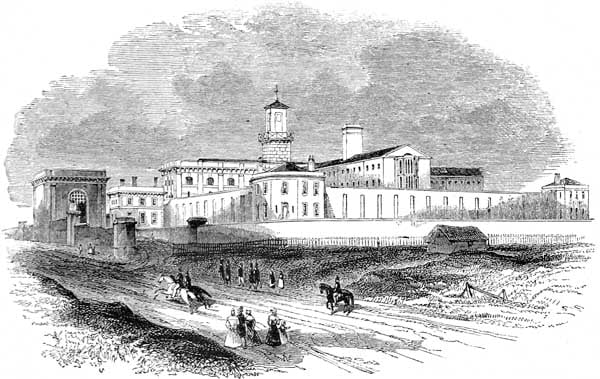
Pentonville Prison designed by Capt Joshua Jebb RE
Two Acts of Parliament allowed for the building of Pentonville Prison for the detention of convicts sentenced to imprisonment or awaiting transportation. Construction started on 10 April 1840 and was completed in 1842. The cost was £84,186 12s 2d. Captain (later Major General Sir) Joshua Jebb designed Pentonville Prison, introducing new concepts such as single cells with good heating, ventilation and sanitation.[26]
Boundary Commissions
Although mapping by what became the Ordnance Survey was born out of military necessity it was soon realised that accurate maps could be also used for civil purposes. The lessons learnt from this first boundary commission were put to good use around the world where members of the Corps have determined boundaries on behalf of the British as well as foreign governments; some notable boundary commissions include:[27]
1839 – Canada-United States
1858 – Canada-United States (Captain (later General Sir) John Hawkins RE)
1856 and 1857 – Russo-Turkish (Lieutenant Colonel (later Sir) Edward Stanton RE)
1857 – Russo-Turkish (Colonel (later Field Marshal Sir) Lintorn Simmons RE)
1878 – Bulgarian
1880 – Græco-Turkish (Major (later Major General Sir) John Ardagh RE)
1884 – Russo-Afghan (Captain (later Colonel Sir) Thomas Holdich RE)
1894 – India-Afghanistan (Captain (later Colonel Sir) Thomas Holdich RE)
1902 – Chile-Argentine (Colonel Sir Delme Radcliffe RE)
1911 – Peru-Bolivia (Major A. J. Woodroffe RE)
Much of this work continues to this day. The reform of the voting franchise brought about by the Reform Act (1832), demanded that boundary commissions were set up. Lieutenants Dawson and Thomas Drummond (1797–1839), Royal Engineers, were employed to gather the statistical information upon which the Bill was founded, as well as determining the boundaries and districts of boroughs. It was said that the fate of numerous boroughs fell victim to the heliostat and the Drummond light, the instrument that Drummond invented whilst surveying in Ireland.[28]
Abney Level
An Abney level is an instrument used in surveying which consists of a fixed sighting tube, a movable spirit level that is connected to a pointing arm, and a protractor scale. The Abney level is an easy to use, relatively inexpensive, and when used correctly an accurate surveying tool. The Abney level was invented by Sir William de Wiveleslie Abney (1843–1920) who was a Royal Engineer, an English astronomer and chemist best known for his pioneering of colour photography and colour vision. Abney invented this instrument under the employment of the Royal School of Military Engineering in Chatham, England, in the 1870s.[29]
H.M. Dockyards
In 1873, Captain Henry Brandreth RE was appointed Director of the Department of Architecture and Civil Engineering, later the Admiralty Works Department. Following this appointment many Royal Engineer officers superintended engineering works at Royal Navy Dockyards in various parts of the world, including the Royal Naval Dockyard, Bermuda.[30]
Chatham Dockyard
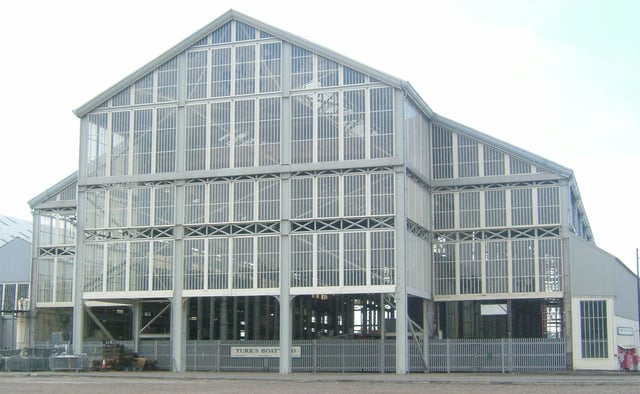
Slip 7 at Chatham Dockyard, designed by Col. G. Greene RE
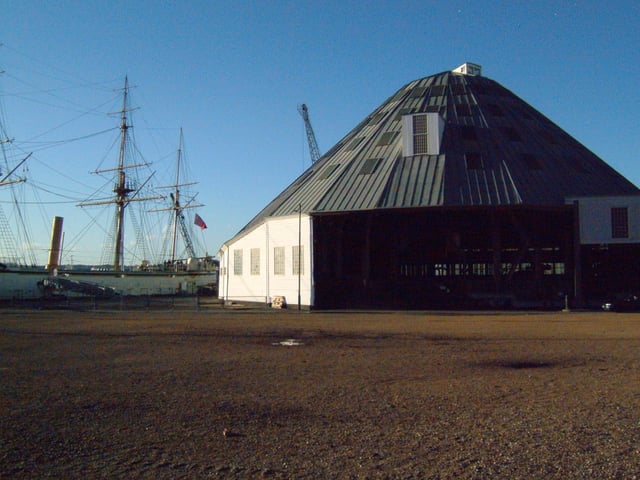
Slip 3 at Chatham Dockyard, designed and built by the Corps
Chatham, being the home of the Corps, meant that the Royal Engineers and the Dockyard had a close relationship since Captain Brandreth's appointment. At the Chatham Dockyard, Captain Thomas Mould RE designed the iron roof trusses for the covered slips, 4, 5 and 6. Slip 7 was designed by Colonel Godfrey Greene RE on his move to the Corps from the Bengal Sappers & Miners. In 1886 Major Henry Pilkington RE was appointed Superintendent of Engineering at the Dockyard, moving on to Director of Engineering at the Admiralty in 1890 and Engineer-in-Chief of Naval Loan Works, where he was responsible for the extension of all major Dockyards at home and abroad.[31]
Trades
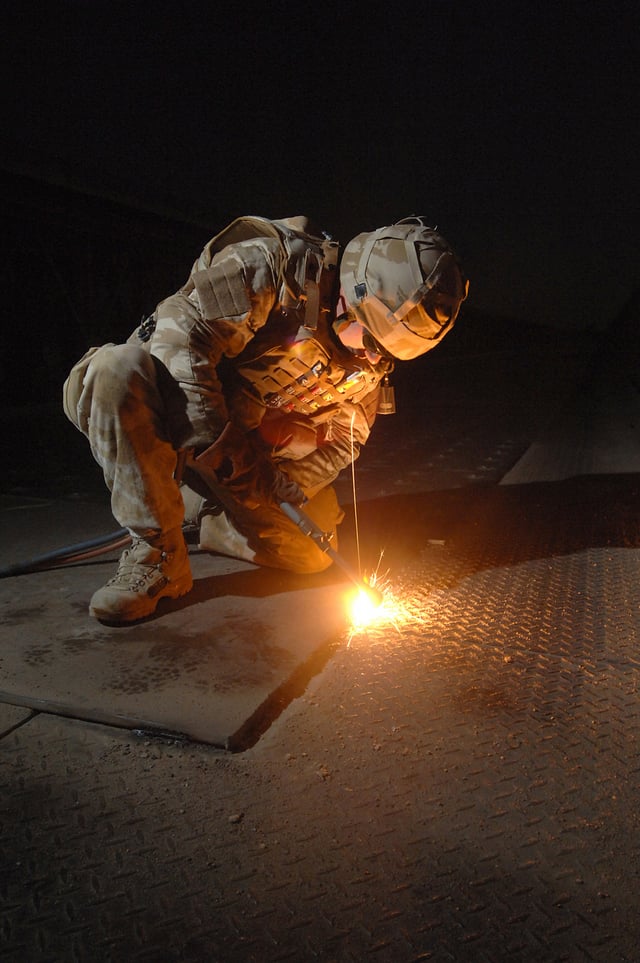
ME – Fabricator in Iraq
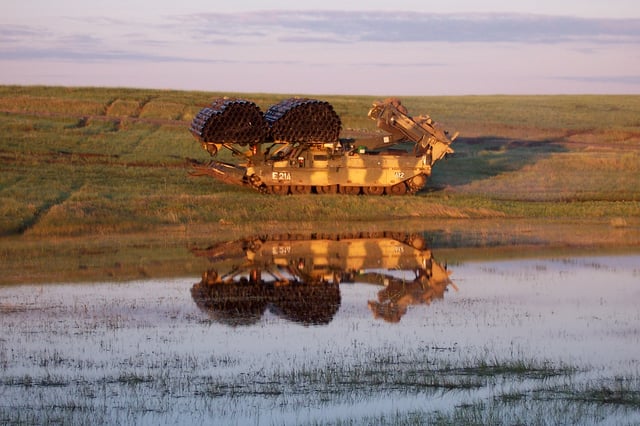
ME – Armoured operating an AVRE in Canada
All members of the Royal Engineers are trained combat engineers and all sappers (privates) and non-commissioned officers also have another trade. These trades include: air conditioning fitter, electrician, general fitter, plant operator mechanic, plumber, bricklayer, plasterer / painter, carpenter & joiner, fabricator, building materials technician, design draughtsman, electrical & mechanical draughtsman, geographic support technician, survey engineer, armoured engineer, driver, engineer IT, engineer logistics specialist, amphibious engineer, bomb disposal specialist, diver or search specialist.[32] They may also undertake the specialist selection and training to qualify as Commandos or Military Parachutists. Women are eligible for all Royal Engineer specialities.[33]
Units
Brigades & Groups
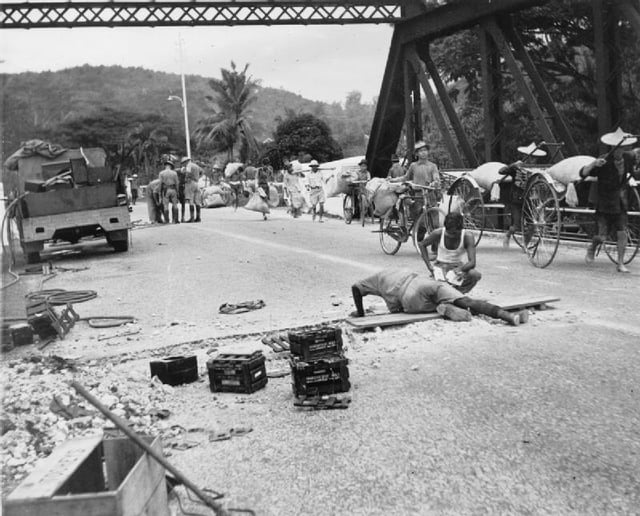
Combat Engineers prepare a bridge for demolition in Malaya.

Royal Engineers' Surveyors in Europe
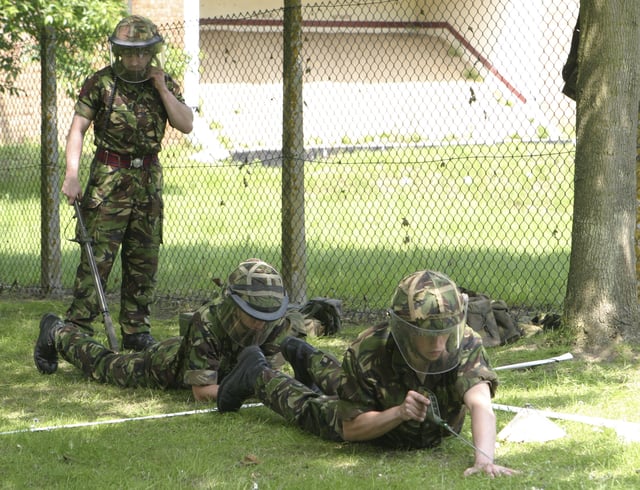
Combat Engineers of 20 Field Squadron, 36 Engineer Regiment practice landmine clearance.
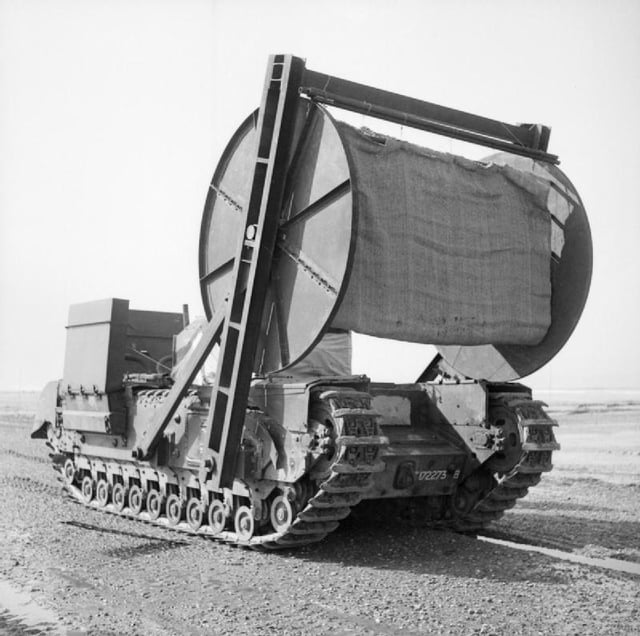
Armoured Vehicle Royal Engineers, Bobin, on D Day
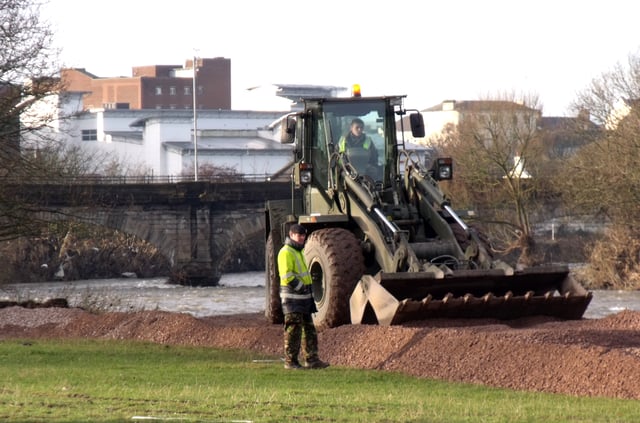
RE Plant Operators construct foundations for a new bridge in Workington after floods

Sappers launching a Logistic Support Bridge at Workington in order to reduce effects of collapsed bridges
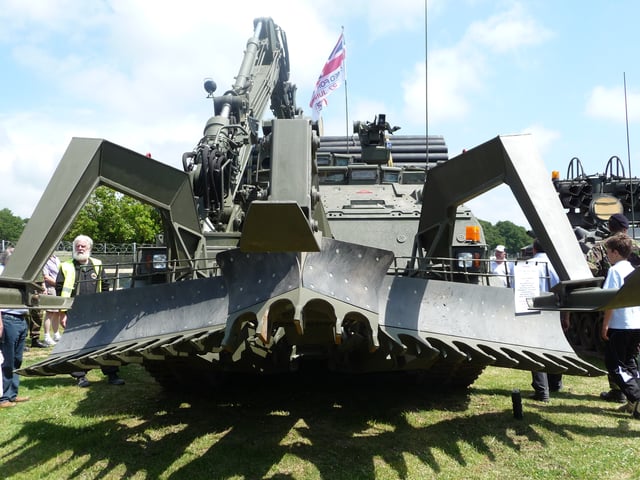
TROJAN AVRE with Full Width Mine Plough and Fascine.
8th Engineer Brigade 12 Force Support Group[34] 21 Engineer Regiment 28 Engineer Regiment[35] 32 Engineer Regiment 36 Engineer Regiment 39 Engineer Regiment 29 EOD & Search Group[36] 33 Engineer Regiment (EOD) 35 Engineer Regiment (EOD) - Formerly 35 Armoured Engineer Regiment 101 (City of London) Engineer Regiment (Army Reserve) 11 Explosive Ordnance Disposal and Search Regiment RLC 1 Military Working Dog Regiment 170 (Infrastructure Support) Engineer Group (previously Military Works Force)[37] 42 Headquarters & Support Squadron 20 Works Group[38] 510 Specialist Team Royal Engineers (Airfields) (Army Reserve) 529 Specialist Team Royal Engineers (Air Support) 531 Specialist Team Royal Engineers (Airfields) 532 Specialist Team Royal Engineers (Air Support) 534 Specialist Team Royal Engineers (Airfields) 62 Works Group[39] 508 Specialist Team Royal Engineers (Wks) (Army Reserve) 519 Specialist Team Royal Engineers (Wks) 522 Specialist Team Royal Engineers (Wks) 523 Specialist Team Royal Engineers (Wks) 524 Specialist Team Royal Engineers (Wks) 63 Works Group[40] 517 Specialist Team Royal Engineers (Wks) 518 Specialist Team Royal Engineers (Wks) 525 Specialist Team Royal Engineers (Wks) (Army Reserve) 527 Specialist Team Royal Engineers (Wks) 535 Specialist Team Royal Engineers (Wks) 65 Works Group[41] (Army Reserve) 503 Specialist Team Royal Engineers (FP) 504 Specialist Team Royal Engineers (P) 506 Specialist Team Royal Engineers (W) 507 Specialist Team Royal Engineers (R) 509 Specialist Team Royal Engineers (PI) 526 Specialist Team Royal Engineers (Wks) 66 Works Group [42] (Air Support) 502 Specialist Team Royal Engineers (FP) 516 Specialist Team Royal Engineers (BP) 521 Specialist Team Royal Engineers (WD) 528 Specialist Team Royal Engineers (P) 530 Specialist Team Royal Engineers (M)
25 (Close Support) Engineer Group (Part of 3rd Division)[43] 22 Engineer Regiment 26 Engineer Regiment
Regiments
21 Engineer Regiment:[44] 7 Headquarters and Support Squadron 1 Field Squadron 4 Field Squadron 29 Field Squadron[45] 106 (West Riding) Field Squadron (Army Reserve), in Sheffield and Bradford REME Light Aid Detachment
22 Engineer Regiment:[44] 6 Headquarters and Support Squadron 3 Armoured Engineer Squadron 5 Armoured Engineer Squadron 52 Armoured Engineer Squadron Royal Electrical and Mechanical Engineers Light Aid Detachment (Army Reserve)
23 Parachute Engineer Regiment – part of 16 Air Assault Brigade[46] 12 Nova Scotia Headquarters and Support Squadron (Air Support)[47] 9 Parachute Squadron 51 Parachute Squadron 299 Para Field Squadron (Army Reserve), in Wakefield, Hull, and Gateshead
24 Commando Royal Engineers – part of 3 Commando Brigade, Royal Marines (based in Chivenor)[44] 54 Commando Squadron 59 Commando Squadron 131 Commando Squadron (Army Reserve), in Kingsbury, Plymouth, Birmingham, and Bath
26 Engineer Regiment:[44] 38 Headquarters and Support Squadron 8 Armoured Engineer Squadron 30 Armoured Engineer Squadron 33 Armoured Engineer Squadron
28 Engineer Regiment (CBRN)[48] 64 Headquarters and Support Squadron 42 Field Squadron 77 Field Squadron FALCON Squadron, Royal Tank Regiment
32 Engineer Regiment:[44] 2 Headquarters and Support Squadron 26 Armoured Field Squadron 31 Armoured Field Squadron 37 Armoured Field Squadron[49]
33 Engineer Regiment (EOD):[44] 49 Field Squadron 58 Field Squadron 821 Field Squadron[50]
35 Engineer Regiment (EOD):[44] 15 Armoured Field Squadron 17 Field Squadron 21 Field Squadron
36 Engineer Regiment:[44] 50 Headquarters & Support Squadron 20 Field Squadron 69 Gurkha Field Squadron 70 Gurkha Field Squadron 61 Field Support Squadron
39 Engineer Regiment:[44] 60 Headquarters and Support Squadron 34 Field Squadron 48 Field Squadron 53 Field Squadron 65 Field Support Squadron REME Workshop
42 Engineer Regiment (Geographic):[44] 13 Geographic Squadron 14 Geographic Squadron 16 Geographic Support Squadron 135 Geographic Squadron (Army Reserve), in Ewell, Wyton, and Reading
71 Engineer Regiment (Army Reserve)[44] Regimental Headquarters at Leuchars Station 102 Field Squadron, in Paisley and Barnsley Bridge 103 (1st Newcastle) Field Squadro, in Newcastle and Sunderland 124 Field Support Squadron, in Cumbernauld, Leuchars, Kinloss, and on the Orkney Islands 591 (Antrim Artillery) Field Squadron, in Bangor, Northern Ireland 10 (Orkney) Troop, in Kirkwall 236 Troop, in Kinloss
75 Engineer Regiment (Army Reserve)[44] 107 (Lancashire and Cheshire) Field Squadron, in Birkenhead 202 Field Support Squadron, in Manchester 412 Amphibious Engineer Troop, in Minden, Germany
101 (City of London) Engineer Regiment (EOD) (Army Reserve):[44] 217 Field Squadron (EOD), in Ilford and Southend) 221 Field Squadron (EOD), in Bexleyheath and Catford) 350 Field Squadron (EOD), in Chilwell and Chesterfield) 579 Field Squadron (EOD), in Tunbridge Wells, Rochester and Redhill)
Royal Monmouthshire Royal Engineers (Militia)[44] Regimental Headquarters Troop, at Monmouth Castle 100 Field Squadron, in Cwmbran, Bristol, Cardiff, and Swansea 108 (Welsh) Field Squadron, in Swansea 225 Field Squadron, in Birmingham Jersey Field Squadron, in St Helier Engineer and Logistic Staff Corps[44] Nottingham Band, Royal Engineers[44]
The Royal School of Military Engineering
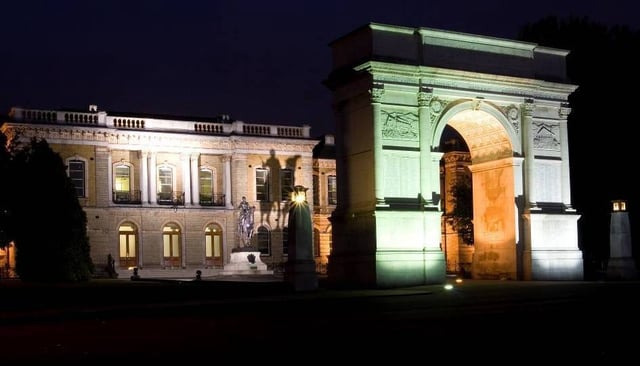
HQ Royal School of Military Engineering.
The Royal School of Military Engineering is the British Army's Centre of Excellence for Military Engineering, Explosive Ordnance Disposal (EOD), and counter terrorist search training. Located on several sites in Chatham, Kent, Camberley in Surrey and Bicester in Oxfordshire the Royal School of Military Engineering offers superb training facilities for the full range of Royal Engineer skills. The RSME was founded by Major (later General Sir) Charles Pasley, as the Royal Engineer Establishment in 1812.[51] It was renamed the School of Military Engineering in 1868 and granted the "Royal" prefix in 1962.[52]
Royal School of Military Engineering[53] Combat Engineer School 3 Royal School of Military Engineering Regiment, in Minley:[44] 55 Training Squadron 57 Training Squadron 63 Headquarters and Training Support Squadron Communication Information Systems Wing Construction Engineer School 1 Royal School of Military Engineering Regiment, in Chatham:[44] 24 Training Squadron 36 Training Squadron Boat Operations Hackett Troop (Plant) Civil Engineering Wing Electrical and Mechanical Wing Royal Engineers Warfare Wing (Founded in 2011 and split between Brompton Barracks, Chatham and Gibraltar Barracks at Minley in Hampshire, this is the product of the amalgamation between Command Wing, where Command and Tactics were taught and Battlefield Engineering Wing, where combat engineering training was facilitated.) United Kingdom Mine Information and Training Centre Defence Explosive Munitions and Search School (formally Defence EOD School and the National Search Centre)
28 Training Squadron, Army Training Regiment[54]
Diving Training Unit (Army), (DTU(A))[55]
Band of the Corps of Royal Engineers (The Band are part of the Corps of Army Music, but wear the uniform of the Royal Engineers)[56]
Corps' Ensign
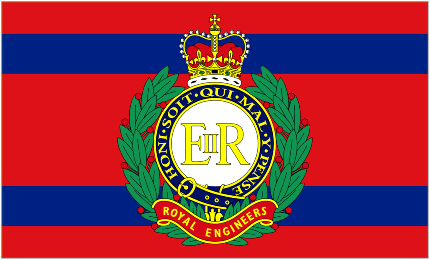
Camp Gate Flag of the Royal Engineers

Royal Engineers' Ensign
The Royal Engineers, Ports Section, operated harbours and ports for the army and used mainly specialised vessels such as tugs and dredgers. During the Second World War the Royal Engineers' Blue Ensign was flown from the Mulberry harbours.[57]
Bishop Gundulf, Rochester and King's Engineers
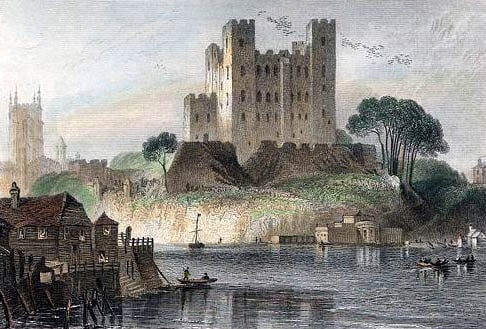
Rochester Castle from across the Medway. Engraving from image by G.F. Sargent c1836.
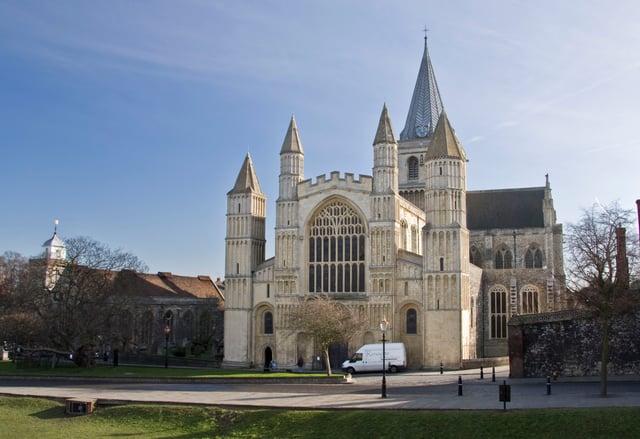
Rochester Cathedral from the West
Bishop Gundulf, a monk from the Abbey of Bec in Normandy came to England in 1070 as Archbishop Lafranc's assistant at Canterbury. His talent for architecture had been spotted by King William I and was put to good use in Rochester, where he was sent as bishop in 1077. Almost immediately the King appointed him to supervise the construction of the White Tower, now part of the Tower of London in 1078. Under William Rufus he also undertook building work on Rochester Castle. Having served three kings of England and earning "the favour of them all", Gundulf is accepted as the first "King's Engineer".[58]
The Institution of Royal Engineers

The Ravelin Building at the Royal School of Military Engineering, Chatham, is now home to the Institution and the Corps Museum.
The Institution of Royal Engineers, the professional institution of the Corps of Royal Engineers, was established in 1875 and in 1923 it was granted its Royal Charter by King George V. The Institution is collocated with the Royal Engineers Museum, within the grounds of the Royal School of Military Engineering at Brompton in Chatham, Kent.[59]
The History of the Corps of Royal Engineers is currently in its 12th volume. The first two volumes were written by Major General Whitworth Porter and published in 1889.[60]
The Sapper is published by the Royal Engineers Central Charitable Trust and is a bi-monthly magazine for all ranks.[61]
The Royal Engineers' Association
The Royal Engineers Association was formed to promote and support the Corps among members of the Association in the following ways:[62]
By fostering esprit de corps and a spirit of comradeship and service.
By maintaining an awareness of Corps traditions.
By acting as a link between serving and retired members of the Corps.
To provide financial and other assistance to serving and former members of the Corps, their wives, widows and dependants who are in need through poverty.
To make grants, within Association guidelines, to the Army Benevolent Fund and to other charities which further the objectives of the Association.
Sport
Royal Engineers' Yacht Club

Un-defaced Blue Ensign flown by members of the REYC.
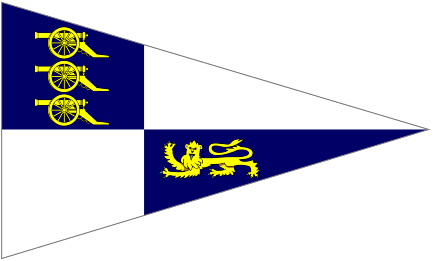
REYC Burgee.
The Royal Engineers' Yacht Club, which dates back to 1812, promotes the skill of watermanship in the Royal Engineers.[63]
Royal Engineers Amateur Football Club
The club was founded in 1863, under the leadership of Major Francis Marindin. Sir Frederick Wall, who was the secretary of The Football Association 1895–1934, stated in his memoirs that the "combination game" was first used by the Royal Engineers A.F.C. in the early 1870s.[64][65][66] Wall states that the "Sappers moved in unison" and showed the "advantages of combination over the old style of individualism".
FA Cup
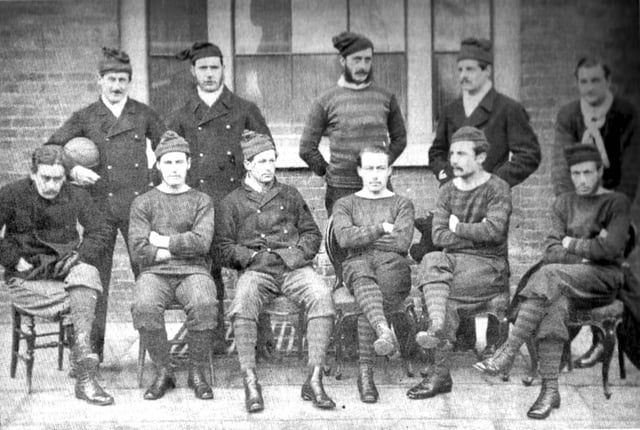
The Royal Engineers pictured in 1872. Back: Merriman, Ord, Marindin, Addison, Mitchell; Front: Hoskyns, Renny-Tailyour, Creswell, Goodwyn, Barker, Rich.
The Engineers played in the first-ever FA Cup Final in 1872, losing 1–0 at Kennington Oval on 16 March 1872, to regular rivals Wanderers.[67] They also lost the 1874 FA Cup Final, to Oxford University A.F.C..
Their greatest triumph was the 1874–75 FA Cup.[67] In the final against Old Etonians, they drew 1–1 with a goal from Renny-Tailyour and went on to win the replay 2–0 with a goal each from Renny-Tailyour and Stafford.[68] Their last FA Cup Final appearance came in 1878, again losing to the Wanderers.[67] They last participated in 1882–83 FA Cup, losing 6–2 in the fourth round to Old Carthusians F.C..[67]
The Engineers' Depot Battalion won the FA Amateur Cup in 1908.[69]
Rugby
The Army were represented in the very first international by two members of the Royal Engineers, both playing for England, Lieutenant Charles Arthur Crompton RE and Lieutenant Charles Sherrard RE.[72]
Successor units
Several units have been formed from the Royal Engineers.
The Air Battalion Royal Engineers (formed 1911) was the precursor of the Royal Flying Corps (formed 1912) which evolved into the Royal Air Force in 1918.[10]
The Telegraph Troop, founded in 1870,[73] [] became the Telegraph Battalion Royal Engineers who then became the Royal Engineers Signals Service, which in turn became the independent Royal Corps of Signals in 1920.[74]
The Royal Engineers were responsible for railway and inland waterway transport, port operations and movement control until 1965, when these functions were transferred to the new Royal Corps of Transport. (See also Railway Operating Division.)[75] The Royal Corps of Transport merged into the Royal Logistic Corps in 1993.[76]
In 1913, the Army Post Office Corps (formed in 1882) and the Royal Engineers Telegraph Reserve (formed in 1884) amalgamated to form the Royal Engineers (Postal Section) Special Reserve. This later became the Defence Postal and Courier Service and remained part of the RE until the formation of the Royal Logistic Corps in 1993 – see (British Forces Post Office).[77]
Notable personnel
Category:Royal Engineers soldiers
Category:Royal Engineers officers
Engineering equipment
Order of precedence
| Preceded by Royal Regiment of Artillery | Order of Precedence | Succeeded by Royal Corps of Signals |
Decorations
Victoria Cross
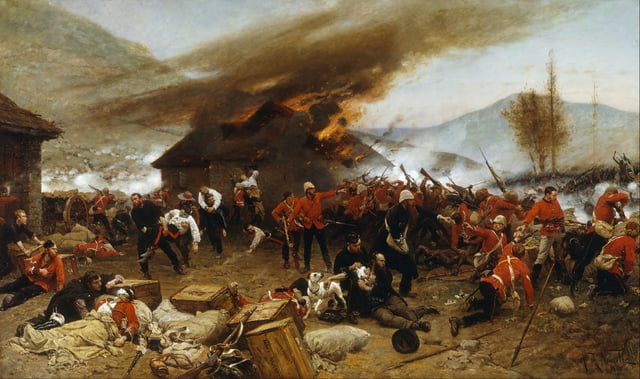
Rorke's Drift, 22–23 January 1879, a battle fought under the command of Lt. John Chard, RE. Eleven Victoria Crosses were won during the battle, including one by Chard. Painting by Alphonse de Neuville
The following Royal Engineers have been awarded the Victoria Cross (VC), the highest and most prestigious award for gallantry in the face of the enemy that can be awarded to British and Commonwealth forces.[78]
Tom Edwin Adlam, 1916, Thiepval, France
Adam Archibald, 1918, Ors, France
Fenton John Aylmer, 1891, Nilt Fort, India
Mark Sever Bell, 1874, Battle of Ordashu, Ashanti (now Ghana)
John Rouse Merriott Chard, 1879, Rorke's Drift, South Africa
Brett Mackay Cloutman, 1918, Pont-sur-Sambre, France
Clifford Coffin, 1917, Westhoek, Belgium
James Morris Colquhoun Colvin, 1897, Mohmand Valley, India
James Lennox Dawson, 1915, Hohenzollern Redoubt, France
Robert James Thomas Digby-Jones, 1900, Ladysmith, South Africa
Thomas Frank Durrant, 1942, St. Nazaire, France
Howard Craufurd Elphinstone, 1855, Sevastopol, Crimea
George de Cardonnel Elmsall Findlay, 1918, Catillon, France
Gerald Graham, 1855, Sevastopol, Crimea
William Hackett, 1916, Givenchy, France
Reginald Clare Hart, 1879, Bazar Valley, Afghanistan
Lanoe Hawker, 1915 {While serving with the RFC}
Charles Alfred Jarvis, 1914, Jemappes, Belgium
Frederick Henry Johnson, 1915, Hill 70, France
William Henry Johnston, 1914, Missy, France
Frank Howard Kirby, 1900, Delagoa Bay Railway, South Africa
Cecil Leonard Knox, 1918, Tugny, France
Edward Pemberton Leach, 1879, Maidanah, Afghanistan
Peter Leitch, 1855, Sevastopol, Crimea
William James Lendrim, 1855, Sevastopol, Crimea
Wilbraham Oates Lennox, 1854, Sevastopol, Crimea
Henry MacDonald, 1855, Sevastopol, Crimea
Cyril Gordon Martin, 1915, Spanbroekmolen on the Messines Ridge, Belgium
James McPhie, 1918, Aubencheul-au-Bac, France
Philip Neame, 1914, Neuve Chapelle, France
John Perie, 1855, Sevastopol, Crimea
Claud Raymond, 1945, Talaku, Burma (now Myanmar)
John Ross, 1855, Sevastopol, Crimea
Michael Sleavon, 1858, Jhansi, India
Arnold Horace Santo Waters, 1918, Ors, France
Thomas Colclough Watson, 1897, Mamund Valley, India
Theodore Wright, 1914, Mons, Belgium
The Sapper VCs
In 1998, HMSO published an account of the 55 British and Commonwealth 'Sappers' who have been awarded the Victoria Cross. The book was written by Colonel GWA Napier, former Royal Engineers officer and a former Director of the Royal Engineers Museum. The book defines a 'Sapper' as any "member of a British or Empire military engineer corps, whatever their rank, speciality or national allegiance", and is thus not confined to Royal Engineers.[79]
Memorials
Rochester Cathedral, Kent has major historical links with the Corps and contains many memorials including stained glass, mosaics and plaques. The cathedral hosts services on the annual Corps Memorial Weekend and is supported by the Corps on Remembrance Sunday.
Royal Engineers First World War memorial at La Ferté-sous-Jouarre
National Memorial Arboretum at Alrewas, Staffordshire
The memorial to the Royal Engineers at Arromanches, the site of the Mulberry Harbours during the Second World War[80]
See also
Royal Electrical and Mechanical Engineers
Mine Information Training Centre
Royal Engineers, Columbia Detachment
Bermuda Volunteer Engineers, a territorial unit that replaced the Regular Army RE companies of the Bermuda Garrison in 1930. Disbanded 1946.
Canadian Military Engineers, created in 1903 to provide a replacement for the RE in Canada
List of international professional associations
The Association of British Columbia Land Surveyors
Institution of Engineers
AVRE